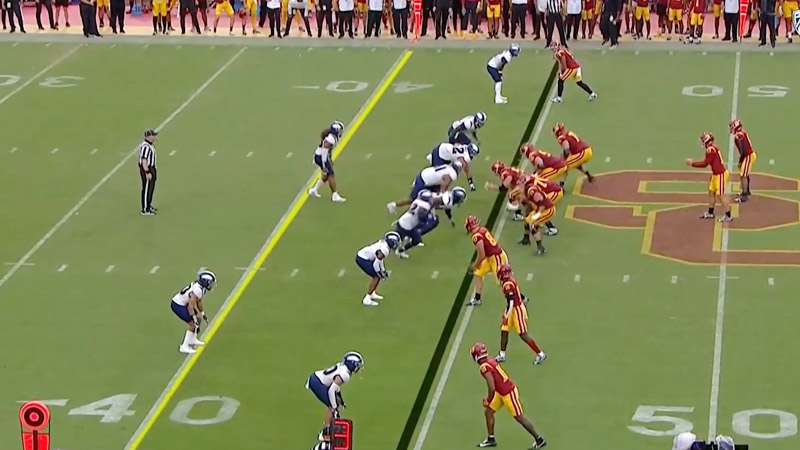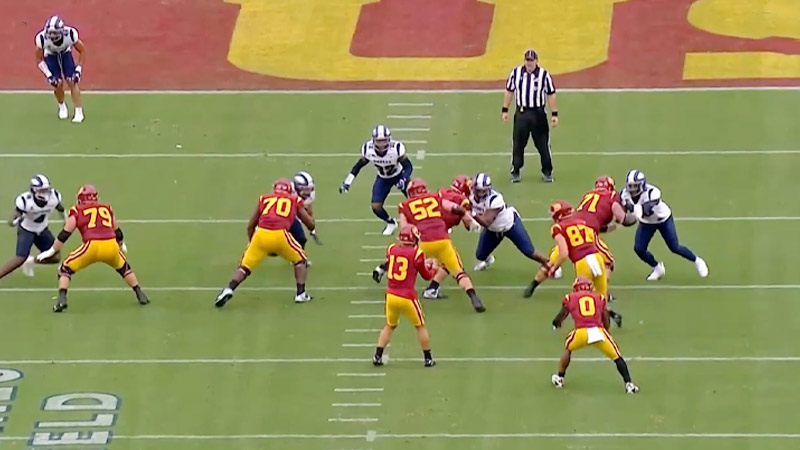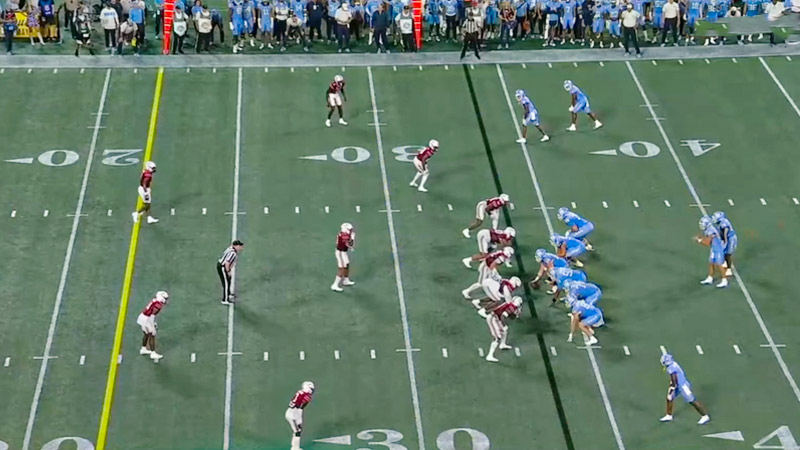In the dynamic world of football, an effective defense is crucial to winning games, and a significant aspect of the defensive strategy revolves around football coverage types.
How a team chooses to cover receivers and defend against passing plays can make or break a game. In this blog post, we will delve into the various football coverage types used by defensive coordinators and explore the strengths and weaknesses of each strategy.
Whether it’s the intensity of man-to-man coverage, the flexibility of zone defense, or the aggression of blitzing coverage, understanding these techniques is essential for any football enthusiast.
Let’s dive into some frequently asked questions to shed light on the intricacies of football coverage.
What Is Football Coverage?
Football coverage refers to the defensive strategy employed by a team to defend against the opponent’s passing plays. It dictates how defensive players position themselves on the field and their responsibilities in covering receivers.
There are different types of coverage, including man-to-man and zone coverage. In man-to-man coverage, defenders are assigned to specific offensive players and closely follow them to prevent receptions.
Zone coverage involves defenders guarding designated areas of the field, focusing on the passing lanes. The choice of coverage depends on the situation, offensive formation, and the strengths of the defensive players.
Effective coverage requires coordination, communication, and quick decision-making by the defenders to disrupt the opponent’s passing game, force turnovers, and ultimately, limit their scoring opportunities.
Major Types of Football Coverage

Football coverage types refer to the defensive strategies used by a team to defend against the opposing team’s passing plays. These coverages dictate how defenders position themselves on the field and how they are responsible for covering receivers.
Each coverage type has its strengths and weaknesses, and coaches often use a combination of these coverages to keep the offense guessing and adapt to different situations during a game.
Let’s elaborate on some of the main football coverage types:
Man-to-Man Coverage
In man-to-man coverage, each defensive player is assigned to cover a specific offensive player or receiver. The defender follows the assigned receiver all over the field, staying with them closely, and aims to prevent them from catching the ball.
This type of coverage is most effective when the defenders are skilled and agile, as they must stick to their assigned receivers and not allow much separation. Man-to-man coverage is often used in critical situations when a team wants tight coverage on key players.
Zone Coverage
In zone coverage, defenders are responsible for specific areas or zones on the field rather than covering individual players. The defenders work together to protect their assigned areas and react to offensive players entering their zones.
Zone coverage is effective in preventing deep passes and helps defend against crossing routes and plays with multiple receivers. However, it can leave gaps in coverage if not executed properly.
Blitzing Coverage
Blitzing coverage is an aggressive defensive strategy where additional players (usually linebackers or defensive backs) rush toward the quarterback to pressure and disrupt the passing game.
This coverage is used to create chaos for the quarterback and force quick decisions, potentially leading to turnovers or sacks. However, blitzing leaves the defense vulnerable in coverage, especially if the quarterback can quickly identify and exploit the open passing lanes.
Man Coverage Play Calls
In man coverage play calls, defensive coordinators may use terms like “Cover 1,” “Cover 0,” or “Man-Free.” Cover 1 typically involves one deep safety with man-to-man coverage on the receivers and is commonly used when the defense wants to apply pressure on the quarterback.
Cover 0 means there is no deep safety, and all defensive players are in man-to-man coverage, usually used in critical situations where the defense needs to stop a crucial play.
Zone Coverage Play Calls
Zone coverage play calls can include “Cover 2,” “Cover 3,” “Cover 4,” and variations thereof. Cover 2 involves two deep safeties splitting the field and each cornerback covering a deep half of the field. Cover 3 has three deep defenders, each responsible for a deep third of the field.
Cover 4 involves four deep defenders, each responsible for a deep quarter of the field. Zone coverage play calls are often used to protect against deep passes and provide more coverage against multiple receiving threats.
Minor Types of Football Coverage

Certainly, there are some other minor types that you should learn as well. Let’s explore some additional football coverage types in detail:
Cover 2 Man Under
Cover 2 Man Under is a combination coverage that blends elements of both man-to-man and zone principles. In this coverage, the two deep safeties split the field in half, each responsible for covering their respective deep half.
The cornerbacks play tight man-to-man coverage on the outside receivers while the linebackers and safeties cover the short and intermediate zones in a zone coverage fashion.
This coverage is effective against short and intermediate passing routes while still providing safety help over the top.
Cover 3 Sky
Cover 3 Sky is a variation of the standard Cover 3 zone coverage. In this coverage, the defense deploys a single high safety responsible for covering one-third of the deep field while the remaining two cornerbacks and the underneath defenders cover their respective zones.
The term “Sky” refers to the strong side of the formation where the cornerback plays a press technique, disrupting the receiver’s route at the line of scrimmage. Cover 3 Sky is effective against vertical passing routes and is commonly used on early downs to prevent big plays.
Cover 4 Quarters
Cover 4 Quarters, also known as “Quarters Coverage,” is a zone coverage that involves four defensive backs (usually the cornerbacks and safeties) splitting the deep part of the field into four equal quarters.
Each defensive back is responsible for one deep quarter of the field. Cover 4 is designed to defend against deep passing plays, particularly when the offense sends multiple receivers deep. However, it can be susceptible to underneath routes in the intermediate zones.
Cover 6 Buzz
Cover 6 Buzz is another combination coverage that combines elements of Cover 2 and Cover 4. The defense divides the field into two halves, with one cornerback and one safety playing Cover 2 on one side, while the other cornerback and safety playing Cover 4 on the other side.
This coverage is used to provide versatility in defending against different offensive formations and can effectively handle both deep and intermediate passing threats.
Tampa 2
Tampa 2 is a zone coverage that gained prominence with the Tampa Bay Buccaneers in the late 1990s and early 2000s. In Tampa 2, the defense employs two deep safeties responsible for the deep halves of the field, while the middle linebacker drops deep into the middle of the field, covering the intermediate area.
The cornerbacks and remaining linebackers cover the underneath zones. Tampa 2 is effective in defending against deep passing plays and can create turnovers with the middle linebacker’s ability to drop into coverage.
Cover 0 Robber
Cover 0 Robber is a blitzing coverage with man-to-man assignments but a twist in the middle of the field.
The defense sends extra pass rushers, leaving no deep safety (Cover 0), but the defense assigns one of the linebackers or safeties as a “robber” who reads the quarterback’s eyes and looks to jump any short or intermediate routes in the middle of the field.
This coverage is high-risk, high-reward, as it aims to disrupt the passing game and force turnovers.
Football defenses continuously evolve, and defensive coordinators create new variations and concepts to counter modern offensive strategies.
Understanding and executing various coverage types effectively is vital for a successful defense, and it requires coordination, communication, and adaptability among the players on the field.
FAQs
What is man-to-man coverage?
Answer: Man-to-man coverage involves defenders being assigned specific offensive players to cover throughout the play. The defenders closely shadow their assigned receivers to prevent them from making receptions and disrupting the passing game.
How does zone coverage differ from man to man?
Answer: In zone coverage, defenders are responsible for specific areas or “zones” of the field rather than individual players. They guard these zones and react to offensive players entering their area, focusing on covering passing lanes and disrupting routes.
What is blitzing coverage, and when is it used?
Answer: Blitzing coverage is an aggressive defensive strategy where additional players rush toward the quarterback to pressure and disrupt passing plays. It is used to create chaos for the quarterback, forcing quick decisions and potential turnovers, but it leaves the defense vulnerable in coverage.
What are some common man coverage play calls?
Answer: Common man coverage play calls include “Cover 1” (one deep safety with man-to-man coverage), “Cover 0” (no deep safety, all defenders in man-to-man), and “Man-Free” (man-to-man with a free safety deep).
What are the main types of zone coverage play calls?
Answer: Main types of zone coverage play calls include “Cover 2” (two deep safeties splitting the field), “Cover 3” (three deep defenders covering thirds of the field), and “Cover 4” (four deep defenders covering quarters of the field).
Wrapping Up
Football coverage types form the backbone of any effective defensive strategy, allowing teams to adapt and counter the various passing threats presented by the opposing offense.
Man-to-man coverage ensures tight marking on key players, while zone defense provides greater coverage against multiple receiving threats. The art of calling the right coverage lies in a coach’s ability to analyze the offensive formation, quarterback tendencies, and game situation.
Understanding the nuances of these coverage types gives teams a competitive edge and the ability to control the game’s outcome. So, the next time you watch a football match, keep an eye on how teams strategically deploy these coverage types to thwart the opposition and secure victory on the gridiron.







